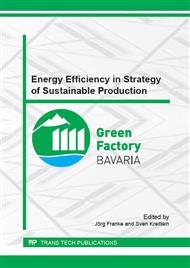p.38
p.46
p.53
p.61
p.67
p.73
p.79
p.86
p.94
Simulation Based Evaluation of Energy Saving Potentials in the Field of Electric Drives Manufacturing
Abstract:
As the production of green products progressively influences customers’ purchase decisions, the development, assessment and controlling of energy sparing processes increasingly has to be focused. Here, one major industry sector that has to be considered is the field of electric drives manufacturing, as the main amount of industrial used energy is consumed in electric engines. Consequently, main research activities in this field focus on the development of stable processes guaranteeing high efficiency levels of the produced motors. However, aside from the products’ energy efficiency, also the energy consumptions of the actual manufacturing steps have to be improved. For this purpose, the present paper presents the main energy consumers within the assembly line of an industrial induction engine. It also explains main energy reduction measures, which were evaluated using a combined material and energy flow simulation. Hereby, the line’s base load as well as the peak load was reduced.
Info:
Periodical:
Pages:
67-72
Citation:
Online since:
November 2015
Authors:
Price:
Сopyright:
© 2015 Trans Tech Publications Ltd. All Rights Reserved
Share:
Citation:


